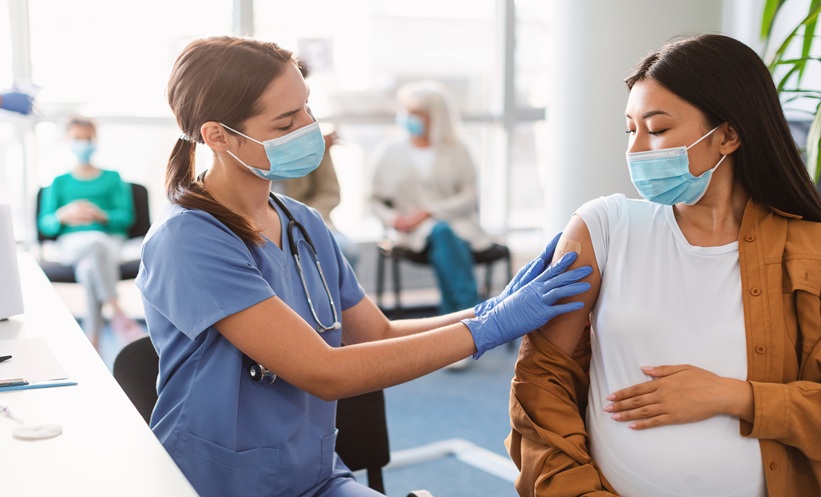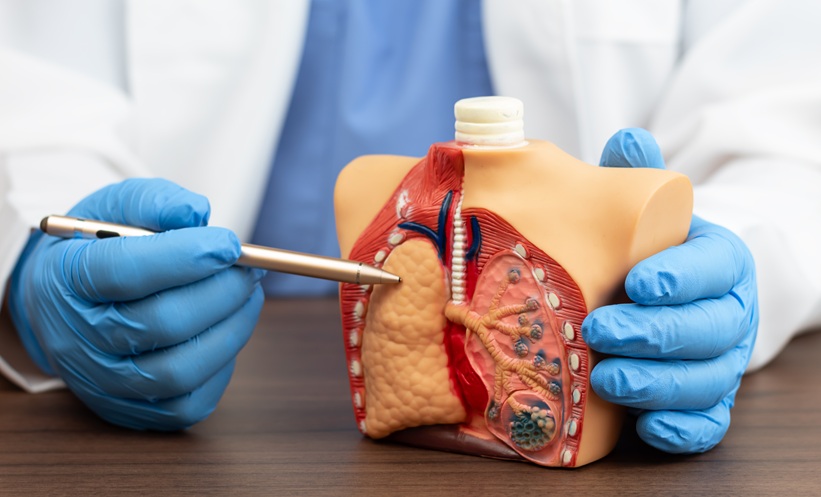PRESENTED in a hybrid format for the first time, this year’s European Respiratory Society (ERS) International Congress welcomed over 19,000 respiratory professionals, with over 10,000 attending in-person in Barcelona, Spain. Known for its stunning buildings, Barcelona is home to many unusual architectural wonders, including Antoni Gaudí’s Casa Batlló, which was classified as a UNESCO World Heritage Site in 2005. For those who could not attend personally, a panoramic view of the city could be seen behind the presenters in the studio.
Christopher E. Brightling, ERS Science Council Chair, who opened the congress with Richard Costello, ERS Education Chair, commented on the in-person registration for the congress: “There was an incredible buzz, a real crowd of people, and that showed me what we had been missing.” However, he also stated that it was fantastic that so many people could join online.
This year, the ERS International Congress saw 3,500 poster sessions, over 500 presentations, and over 300 industry sessions on a variety of topics, including acute and chronic respiratory failure and patient quality of life. Some of the sessions that Brightling was most looking forward to, however, were the four ALERT sessions, which focused on randomised clinical trials that are most likely to have an impact on practice. Another highlight was the Lungs on Fire session, which is now a regular at the ERS International Congress. This innovative, interactive session explored real-life clinical cases where a panel of experts were put to the test against the audience.
A number of awards were presented, including the ERS Presidential Award to Gérald Simonneau, Faculté Médecine, Université Paris Saclay, Le Kremlin-Bicêtre, France, and Centre de Référence de l’Hypertension Pulmonaire, Hopital Marie-Lannelongue, Le Plessis-Robinson, France, for his contribution to strengthening respiratory medicine worldwide. The ERS Congress Chair Award went to Hans Henri P. Kluge, World Health Organization (WHO) Region Office for Europe, Copenhagen, Denmark, for his contribution to research and training.
The ERS Mid-Career Gold Medals were awarded for various specialities, including Asthma, which was presented to Hamida Hammad, Laboratory of Mucosal Immunology and Immunoregulation, VIB-UGent Center for Inflammation Research, Belgium, and Department of Internal Medicine and Pediatrics, Ghent University, Belgium. Francesca Polverino, Asthma and Airway Disease Research Center, University of Arizona, Tucson, USA, was awarded the Gold Medal in Chronic Pulmonary Disease, while Anne Holland, Central Clinical School, Monash University, Melbourne, Australia; Department of Physiotherapy, Alfred Health, Melbourne, Australia; and Institute for Breathing and Sleep, Melbourne, Australia, received the one for Allied Health Professionals. The Non-tuberculous Mycobacteria gold medal was awarded to Andres Floto, Molecular Immunity Unit, University of Cambridge Department of Medicine, MRC Laboratory of Molecular Biology, UK; Cambridge Centre for AI in Medicine, UK; and Cambridge Centre for Lung Infection, Royal Papworth Hospital, UK, and the ERS Mid-Career Gold Medal in Clinical Technique, Imaging, and Endoscopy was awarded to Daniel Steinfort, Faculty of Medicine, Dentistry and Health Sciences, University of Melbourne, Parkville, Australia, and Department of Respiratory and Sleep Medicine, Royal Melbourne Hospital, Parkville, Australia. Gold Medals in Epidemiology and Environment, Cystic Fibrosis, and Pulmonary Arterial Hypertension were awarded to Zorana Jovanovic Andersen, Department of Public Health, University of Copenhagen, Denmark; Pierre-Régis Burgel, Université Paris Cité, L’Institut national de la santé et de la recherche médicale (Inserm) U1016, Institut Cochin, Paris, France; and Christophe Guignabert, L’Institut national de la santé et de la recherche médicale (Inserm) UMR_S 999, Hôpital Marie Lannelongue, Le Plessis-Robinson, France, and School of Medicine, Université Paris-Saclay, Le Kremlin-Bicêtre, France, respectively.
After a fantastic couple of days, Costello rounded up the ERS International Congress by introducing Monika Gappa as the new ERS President for 2023–2024. She stated that she was looking forward to her role and that it was great to be back. Also referring to the COVID-19 pandemic, ERS Science Council Chair Elect Nicolas Roche commented on the “extraordinary” output from ERS and that we are now seeing a return of more “normal” scientific activities.
Next year’s congress will take place in Milan, Italy, from 9th–13th September 2023. Until then, please enjoy our key insights and reviews from this year’s ERS International Congress.
Invasive Versus Bronchoscopic Lung Volume Reduction: Which Is Best?
PIONEERING randomised controlled trial data comparing lung volume reduction surgery (LVRS) and bronchoscopic lung volume reduction (BLVR) as surgical management options for emphysema was presented at ERS International Congress 2022 on 6th September. The overall study findings revealed that both surgeries assessed resulted in similar improvements in lung volume reduction, exercise capacity, and breathlessness.
LVRS involves resection of areas with significant alveolar damage and is therefore more invasive than BLVR, in which a fibreoptic camera is introduced into the lungs to deploy one-way endobronchial valves, which cause partial collapse of the lung adjacent to it. Whilst both interventions have previously documented positive impact on symptoms and lung function, no trials have compared the two to determine which is best.
To address this, a research team, led by Sara Buttery, National Heart and Lung Institute, Imperial College London, UK, conducted a trial which randomised 88 patients to either LVRS (n=41) or BLVR (n=47) to directly compare the procedures to help “inform decision-making when a person seems to be suitable for either.” The mean age of participants was 64 years and patients were followed up for 1 year. Response to the procedure was measured by assessing the percentage change in residual volume in combination with the composite disease severity index score, iBODE, which accounts for BMI, airflow obstruction, dyspnoea, and exercise capacity.
The authors found that both procedures resulted in similar improvements in iBODE scores, reduction in gas trapping, and were equally safe, with one death in each arm of the trial during the 1-year follow-up period.
These promising results provide important information to encourage larger trials with higher power, so that patients and clinicians can have informed conversations and decision making discussions. For the future, Buttery commented that further research to identify patient factors that indicate whether a person would respond better to one procedure or the other and analysis into the cost–benefit of both procedures is required.
Risk of Cancer, Mental Decline, and Blood Clots All Linked to Obstructive Sleep Apnoea
STUDY data presented as ERS International Congress 2022 has indicated that individuals who suffer from obstructive sleep apnoea (OSA) are at an increased risk of cancer. This data was presented alongside a second study which indicated OSA was also linked to a decline in processing powers in the elderly. Finally, a third study found patients with severe OSA were at a greater risk of developing blood clots in their veins.
OSA causes individuals to experience partial or complete obstruction in their airways during sleep and can stop breathing several times throughout the night. The disorder is thought to affect approximately 7–13% of the population. Risk factors include obesity, smoking, and high alcohol consumption.
The first study investigating correlation with cancer examined data from 62,811 patients, 5 years prior to the commencement of OSA treatment. These patients were treated with continuous positive airway pressure and data was collected from the Swedish National Cancer Registry and Statistics Sweden. The researchers identified 2,093 patients with OSA who also had a cancer diagnosis up to 5 years before OSA diagnosis. They found that patients with cancer tended to have more severe OSA and that the O2 desaturation index (ODI) of patients tended to be lower in those with lung cancer.
Looking to the future, the researchers described the need for larger studies with more patients to investigate the potential influence of continuous positive airway pressure treatment on cancer incidence and survival.
The second study presented at ERS International Congress linked OSA with greater mental decline. Individuals aged 65 years and older between 2003 and 2008 were examined with sleep tests to define presence of OSA. This was subsequently followed up with cognitive assessments assessing global cognitive function. The researchers found that low O2 levels during sleep due to OSA were associated with a greater decline in global cognitive function. They further identified that males and those aged over 74 years were at higher risk of cognitive decline related to OSA.
The third OSA study demonstrated a link between severe OSA and venous thromboembolism (VTE) by following 7,355 patients over the course of 6 years. Overall, 104 developed VTEs. The researchers found that individuals who spent more than 6% of sleep with O2 levels below 90% of normal ranges had an almost two-fold increase in the risk of developing VTE compared to patients without nocturnal O2 deprivation.
“These three studies show worrying associations between obstructive sleep apnoea and important diseases that affect survival and quality of life,” explained Winfried Randerath, Bethanien Hospital, University of Cologne, Germany, and Head of the ERS specialist group on sleep disordered breathing. “The data support the relevance of sleep apnoea on cancer, VTE, and mental health. While they cannot prove that OSA causes any of these health problems, people should be made aware of these links and should try to make lifestyle changes to reduce their risk of OSA, for instance, by maintaining a healthy weight. However, if OSA is suspected, definite diagnosis and treatment should be initiated. We look forward to further research that may help to clarify whether OSA may be causing some of the health problems seen in these studies.”
Preventing Croup Before Birth
CHILDREN whose mothers took fish oil and vitamin D supplements during pregnancy are less likely to develop croup, according to Nicklas Brustad, Copenhagen University Hospital, Denmark, who presented the findings of Copenhagen Prospective Studies on Asthma in Childhood (COPSAC) at the ERS International Congress 2022.
A common viral chest infection, croup affects young children who present with a barking cough, hoarse voice, and breathing difficulties. While most cases are mild, some children need breathing support. Brustad noted that there is no vaccine at the moment to prevent the disease; therefore, “other preventative strategies are needed.”
This double-blind study consisted of 736 females who were cared for by COPSAC during their pregnancy. They were divided into four groups, where one group was given a high dose of vitamin D (2,800 IU/day) and fish oil (2.4 g), containing long-chain n-3-polyunsaturated fatty acids. Another group received a high-dose vitamin D and olive oil, while a third were given a standard dose (400 IU/day) of vitamin D and fish oil. The final group were given a standard dose of vitamin D and olive oil. The supplements were taken daily from the patients’ 24th week of pregnancy until 1 week after delivery.
The children were monitored until the age of 3 years and there were 97 cases of croup, diagnosed either by a doctor or through medical records. Children born to mothers who had taken high-dose vitamin D during pregnancy had an 11% risk of croup; however, those whose mother had the standard dose had an 18% risk. There were similar findings when comparing children of mothers who had taken fish oil and olive oil (11% and 17% risk, respectively).
While unsure of the exact mechanisms, Brustad stated: “Our findings suggest that vitamin D and fish oil could be beneficial against childhood croup in sufficiently high doses.” The COPSAC research team will continue looking vitamin D and fish oil to determine if there are any other benefits.
Artificial Intelligence Can Be Used to Detect COVID-19 Infection
COVID-19 can be detected using artificial intelligence (AI) that identifies the infection through people’s voices, using recordings through a mobile app. This research was presented at ERS International Congress 2022 in Barcelona, Spain.
The app could be used in low-income countries, as the test is cheap, quick, easy to use, and more accurate than rapid antigen tests. While rapid antigen tests’ accuracy can vary depending on the brand and is less accurate in asymptomatic people, the AI was accurate 89% of the time.
Since COVID-19 affects the upper respiratory tract and vocal chords, a person’s voice can change, which is why researcher Wafaa Aljbawi, Institute of Data Science, Maastricht University, the Netherlands, and supervisors, investigated whether it was possible to analyse people’s voices to detect the infection through AI. The app first collects basic information, then asks the user to record respiratory sounds, including reading a short sentence on the screen three times, coughing three times, and breathing deeply through their mouth three to five times.
The team used data from the University of Cambridge’s crowd-sourcing COVID-19 Sounds App, including audio samples from 4,352 participants, of whom 308 had tested positive for COVID-19. A voice analysis technique called mel-spectrogram analysis then decomposed the properties of the voice. Different AI models were built in order to distinguish people affected by COVID-19 from those who weren’t.
The app’s sensitivity was of 89%, and its specificity was 83%. Aljbawi said: “They enable remote, virtual testing and have a turnaround time of less than a minute. They could be used, for example, at the entry points for large gatherings, enabling rapid screening of the population.”
Henry Glyde, a PhD student at the University of Bristol, UK, then showed that AI could also be used in patients with chronic obstructive pulmonary disease (COPD) to predict acute exacerbations. The AI could be harnessed via the app myCOPD, which is already used by 15,000 patients with COPD to help manage their disease. Sensitivity for the most recent AI model was 32% and specificity was 95%, meaning that while the app is not as accurate in predicting when a patient will experience an exacerbation, it is very good at predicting when they will not, thereby preventing unnecessary treatment. Improving the sensitivity will be the next phase of the research.
Project lead James Dodd said: “It would empower patients to have more autonomy and control over their health. This is also a significant benefit for their doctors as such a system would likely reduce patient reliance on primary care.”
E-cigarettes: A Route to Nicotine Addiction
TEENAGERS are more likely to try e-cigarettes if their parents are smokers, according to research presented by Luke Clancy, Director General of the TobaccoFree Research Institute Ireland (TFRI), Dublin, Ireland, at this year’s ERS International Congress 2022.
TFRI analysed data from 6,216 teenagers aged 17–18 years, which included information on if their parents were smokers and whether they were also smokers or used e-cigarettes. The researchers combined this information with other Irish datasets, which included 10,000 Irish teenagers aged 16–17 years, to provide a more comprehensive analysis of e-cigarette usage in Ireland.
The results showed that more teenagers tried e-cigarettes in 2019 than 2014 (39% and 23%, respectively). It also highlighted that teenagers were 55% more likely to have tried e-cigarettes and 51% more likely to have tried smoking. However, 29% stated that it was because their friends were vaping, while most teenagers (66%) said that they tried e-cigarettes out of curiosity. Only 3% said they tried e-cigarettes to quit smoking.
Clancy noted: “There’s a perception that vaping is a better alternative to smoking, but our research shows that this doesn’t apply to teenagers who usually haven’t tried cigarettes prior to e-cigarettes. This indicates that, for teens, vaping is a route into nicotine addiction, rather than out of it.”
Looking in more detail at the data from 3,421 teenagers aged 16 years, the researchers found that males are more likely to try e-cigarettes than females; however, they also discovered that the rates are increasing more rapidly amongst females, with 39% saying that they had tried e-cigarettes in 2019 compared with 23% in 2015.
Joan Hanafin, Lead Researcher at TFRI, said: “We can see that the number of teenagers using e-cigarettes is changing fast, so we need to keep monitoring the situation in Ireland and around the world. We also plan to study social media to understand how this influences girls’ and boys’ vaping behaviour.”








